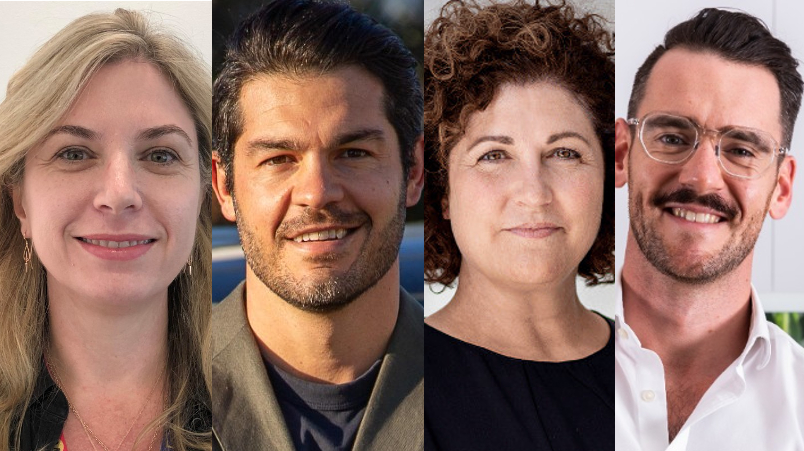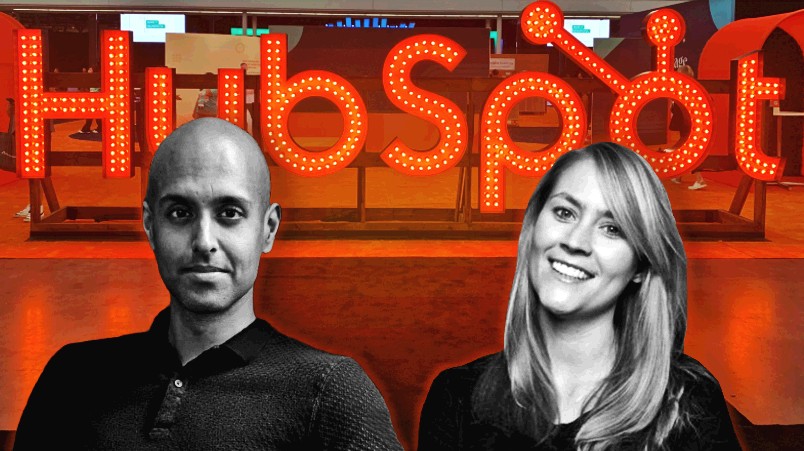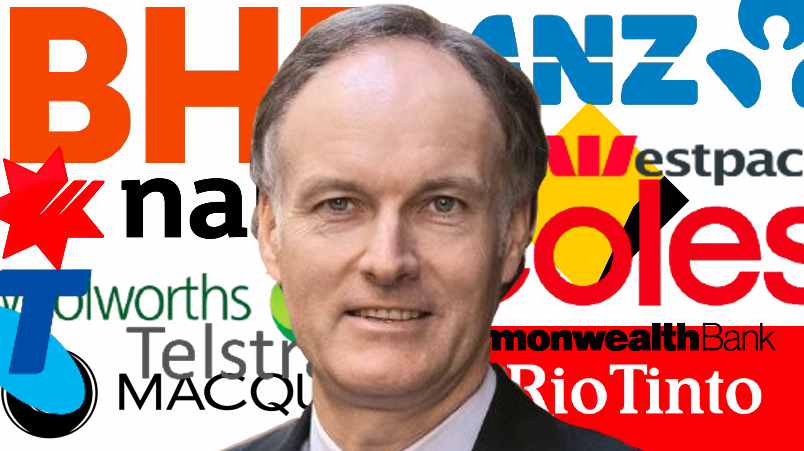CMOs at Kia, Nestlé, Tourism Australia and CMC Markets debate if ex-agency marketers do it differently, or better – and why

L-R: Nestle's Anneliese Douglass, Kia's Dean Norbiato, Tourism Australia's Susan Coghill, and CMC Markets' Liam Loan-Lack.
Those that have crossed the agency-brand divide say agencies can be a little narrow in their understanding of marketing’s full business remit but more often than not, agency experience delivers sharper and faster results. Kia marketing boss Dean Norbiato, Nestlé's Anneliese Douglass, Tourism Australia's Susan Coghill and CMC Markets' Liam Loan-Lack unpack how agency experience has shaped their thinking and growth strategies – but warn brand-side is anything but an easier ride.
What you need to know:
- Kia marketing boss Dean Norbiato was “getting stale” before taking a pay-cut to head agency-side. But it brought fresh perspective to move the needle when going back brand-side with the carmaker.
- Tourism Australia CMO Susan Coghill started out handing agency briefs to Steve Jobs, and preparing to duck flying smoothies. She prefers to hire agency people for their dynamism and creative thinking.
- Nestle’s Anneliese Douglass thinks agencies tend to be braver than corporates, but taking ownership of P&L is a heavy responsibility.
- CMC Markets APAC marketing boss Liam Loan-Lack, a former lawyer, thinks the marketing world should follow legal precedent and drop the brand-agency division altogether.
- Loan-Lack’s advice to agency execs mulling the switch: Accept the best and boldest ideas are often trumped by those easiest to sell internally – and forget about having more control. “It’s not easier, and if anything there is less control.”
- All four marketers were speaking on a panel at the Advertising Council's This Way Up Festival of Creativity.
One thing that I used to absolutely hate was when you would roll out the glamours for a pitch – the agency geniuses who would present something – and everyone at the brand would get caught up. But then [the agency geniuses] would get parked and go over to win another client – and the people who actually did the work were … interns and the work would fail.
Changing swim lanes
Dean Norbiato started out in marketing at Swimming Australia and then Swisse but took a pay cut to join experiential agency Bastion Experience. He thinks it has made him a better marketer, though caveats that there is “no absolute” answer to the debate.
“A good marketer is a good marketer [whether or not they have agency experience]. But if I were to get off the fence, I would say that both agencies and marketers are better if they have experienced the other arena. You get an understanding of where they are coming from [that may otherwise be clouded by] personal bias about your position and you may not actually see what they are saying in a situation.”
“So I think the majority of the best agency people have had brand experience – and vice versa in terms of the perspective that you can take on situations to ultimately get to the single, mutually beneficial position. If you can foster that environment where both parties are going for a shared goal, that's where you get the best outcome.”
Norbiato thinks his agency stint before joining the automotive category, where multi-decade career tenures are the norm, has served him well.
“I was getting stale in my first brand role. I had an opportunity to take a lesser role at an agency or step up and go to a bigger role within my brand.”
He took the agency option.
“It wasn’t financially viable – everybody in adland knows how much you get paid – but I took that decision because I wanted to test myself and build a skill-set and a robust background so that when I then went back to brand, I knew I could do it better. I don't think that breadth of skill-set gets afforded enough into brandland in terms of how it can translate,” says Norbiato.
He thinks agency experience has helped accelerate change at Kia.
“When I first started, there was a certain level of ‘we've always done it this way, this is how we work with agencies’. But they couldn't see the forest from the trees to call out dirty words like commission and have those tough conversations to understand how the money flow operates through businesses,” says Norbiato. “Something as simple, rational and mechanical as that was just not looked at – because there was no one who could see how money could potentially be funnelled into different areas.”
He suggests a better understanding of how agencies work has also led to sharper results – with one less brand falling for the dog and pony show.
“In a pitch environment, one thing that I used to absolutely hate was when you would roll out the glamours at the front – the agency geniuses who would present something – and everyone at the brand would get caught up. But then [the agency geniuses] would get parked and go over to win another client – and the people who actually did the work were … interns, who would come in and the work would fail,” says Norbiato.
“So in every pitch, ensuring that the people who are doing the work are also in the pitch… and having tough conversations means you get to an elevated position. Ultimately the work is better.”
I think agency people are incredibly smart. I love to stack my team with them whenever I can. I can’t say that is what I put into the brief when I recruit… but if you’re asking my personal bias, I’d probably rate them a little higher.
Good talent bias
Tourism Australia CMO Susan Coghill says she has a “personal bias” towards agency talent within her team, following more than a decade at agencies including BBH, M&C Saatchi, Publicis Mojo, Whybin TBWA and The Campaign Palace. Her first gig at Chiat\Day in LA was handing the agency’s brief responses to Apple’s Steve Jobs, notorious at the time for “throwing smoothies at people’s heads in meetings”. Coghill not only survived “unscathed”, but got to sit on the beach in Hawaii “going through the creative with Steve asking my opinion on it”.
In her early agency days, Coghill cast covetous glances at the training and development provided by brands as standard.
“I always thought that was absolutely amazing. I wish that we were a little more structured like that, agency-side. I think agencies have got better, but when I was starting out, it was a lot more about learning on the fly in your job.”
Like Kia’s Dean Norbiato, Coghill took a backward step to cross the agency-brand divide, leaving a group business director role at The Campaign Palace to become a senior marketing manager at Westpac, “because it was the only way at the time to make the transition to brand side”.
On climbing the marketing ladder, Coghill says she increasingly appreciated the diversity of talent and skills agencies bring to the table.
“I really started valuing everything that we see in young agency people, which is a sense of dynamism, a sense of entrepreneurial spirit – problem solvers, creative thinking, hard workers – that sometimes you don't get if you come up through a more traditional sort of client environment that’s a little more institutionalised.”
She says that view holds when it comes to resourcing TA’s marketing department.
“I think agency people are incredibly smart. I love to stack my team with them whenever I can,” says Coghill. “I can’t say that is what I put into the brief when I recruit… but if you’re asking my personal bias, I’d probably rate them a little higher.”
What if we could have a professional path where you did your time in a creative agency, did your time in a media agency, did your time client-side, and then there was a level of professional accreditation, so you are a certified marketer. That would help elevate the work, the thinking, and it would stop the short-termism in our industry.
Follow legal precedent
Liam Loan-Lack swapped UM for marketing roles at My Muscle Chef and more recently, CMC Markets. He thinks the marketing and ad industry should take a legal precedent – literally – when it comes to swapping sides.
“Before I got into marketing, I was going to become a lawyer … and if you are a lawyer, you go and train in private practice in an agency first to learn your craft. And when you move in-house as counsel, there is very little debate or even question about that. People chop and change their whole careers and no one bats an eyelid,” says Loan-Lack.
The industry would achieve greater “growth and maturity” by lifting that playbook and creating a “proper path to be a senior client or senior agency person,” suggests Loan-Lack, “Because at the end of the day, we are all marketers. We just are looking at it from a very different specialism and part of the pie.
“What if we could have a professional path where you did your time in a creative agency, did your time in a media agency, did your time client-side, and then there was a level of professional accreditation, so you are a certified marketer. That would help elevate the work, the thinking, and it would stop the short-termism in our industry.”
Loan-Lack thinks Tourism Australia’s Susan Coghill might be an outlier when it comes to marketers preferencing agency talent.
“I was chatting to a lot of recruiters prior to getting this role at CMC. Pretty much everyone I spoke to questioned whether I wanted to stay client side: ‘Aren’t you really an agency person?’ One recruiter actually said ‘I never get a brief stating that [the client] wants an ex-agency person’. So it is limiting.”
While Coghill admits the marketer “aperture” or remit is “much larger than anything it was when I was agency-side,” Loan-Lack thinks agency people “have a level of resilience which is so valuable”. He thinks the change of pace is also a culture shock.
“I’ve got to hold myself back sometimes. I’m like, ‘That’s the problem, why are we still talking about it? Let’s attack the problem.’ But you just have to be [much more] considered, so that’s a tension.”The wonderful thing that you learn at an agency is bravery. That is what agency people bring to the fore because they aren’t [embedded] in the machine. So they are very brave and that is why you need agencies, to think outside of your category norms and come up with ideas that are going to … attract the consumer.
Bold versus deep
Anneliese Douglass agrees there is a tension between the broad spectrum of marketing remit versus speed and agility. Douglass worked at media agencies including UM and Mindshare before heading brand-side with Unilever. She spent eight years with the FMCG behemoth before joining Nestle as Director – Marketing Communications last year.
She also thinks agencies tend to be bolder than corporates.
“The wonderful thing that you learn at an agency is bravery. That is what agency people bring to the fore because they aren’t [embedded] in the machine. So they are very brave and that is why you need agencies, to think outside of your category norms and come up with ideas that are going to … attract the consumer.”
But she thinks there is “no back and white answer” to the question of whether ex-agency execs make better marketers – because the marketing spectrum is so varied across product, price, place, promotion and beyond.
Speaking “the language of business” is different tongue to master, while Douglass thinks the biggest step up is taking “far more responsibility around the P&L … to me that is a fundamental difference”.
So much of the frustrations that agencies have with clients is because they don’t understand that great output isn’t the stuff that gets bought. It’s the simple work that travels around the client organisation really effectively and easily. And the more senior you are as a client, the more your value is to manage and align your internal stakeholders, which is a mammoth effort.
No less hectic
While agencies are continually spinning plates, life is no less frantic brand-side, per the marketers. It’s just another variant of busy, with a different audience to sell to: bosses, executive committees and compliance teams. That can mean for all agencies’ collective bravery and creative smarts, the best ideas are often trumped by those easiest to sell internally.
“My experience at an agency, while it was hectic … it’s nowhere near being more hectic than working brand-side,” says Kia’s Norbiato.
Tourism Australia’s Coghill agrees.
“There’s a misconception that life is easier on brand-side than on agency-side. My team and broader organisation work as hard, but they do work differently.”
Internal sales pressure
CMC Market’s Liam Loan-Lack had hoped life as a marketer would be easier and afford greater control of the end-to-end process. He was swiftly disabused of that notion.
“It’s not easier and if anything, you have less control,” he says. “There is more accountability and there is actually less control.”
Plus, he suggests there is actually more salesmanship involved. Whereas agencies are selling ideas into the brand, marketers are “selling everyday … I’m selling to the CEO, the CFO and I have a regional role in a global business so I’m selling to my global CMO”, says Loan-Lack. “So it doesn’t get easier.”
Moreover, the selling can involve creative compromise. While agencies are incentivised on “really good output, they want to do good work … client side it’s about simple work that you can easily sell and communicate to stakeholders. They are very different things,” he adds.
“My observation is that so much of the frustrations that agencies have with clients is because they don’t understand that great output isn’t the stuff that gets bought. It’s the simple work that travels around the client organisation really effectively and easily, because it is about the narrative internally that you create,” says Loan-Lack. “And the more senior you are as a client, the more your value is to manage and align your internal stakeholders, which is a mammoth effort.”
I’ve got a management team that stands behind that and a board that sits behind that. We account for that in our risk register. We know there's greater risk in being boring and vanilla and your media and marketing dollars not working as hard as they could.
Corporate risk registers
Tourism Australia’s Susan Coghill says her early experience with Apple and Steve Jobs were “formative” in terms of creativity forming the bedrock of marketing.
“I don't know if I gravitate to brands that have good creative ambition or if it's something I just really try and drive and instil. Making creative part of the agenda, not just within the marketing team, but at an executive and a board level and why it makes commercial sense, for me, is priority number one.”
In a category that is “a complete sea of sameness … every beach features the same sea turtle”, it is imperative to “set the expectations early on, set the creative ambition high”, says Coghill.
“I’ve got a management team that stands behind that and a board that sits behind that. We account for that in our risk register. We know there's greater risk in being boring and vanilla and your media and marketing dollars not working as hard as they could.”
So a federal government agency’s risk register lists being creatively boring as potential business hazard?
“We don’t phrase it that way,” says Coghill, “but … that is part of it … But everyone, they all believe wholeheartedly, as my management team, that there's more risk in being vanilla.”
CMC Markets is at the other end of the spectrum, says Liam Loan-Lack.
“I work for one of the most regulated businesses in the country and we have the opposite [issue]. The more creative we are, the more risk. I have a twelve-strong compliance team who sit opposite me.”
The compliance team is “1,000 per cent” analysing any proposed creative for risk, says Loan-Lack. “We have strict target market definitions under disclosure obligations,” he says, so compared to Tourism Australia, “we have a flip-side view”.
Fresh perspective, results
Kia’s Dean Norbiato thinks coming fresh from an agency into the auto category helped Kia to take a different approach. Though he says it helped to work for a boss who “by proxy had run marketing for a certain period of time – who just said ‘look out for opportunities where we can grow’.”
That afforded him the freedom to do things differently in a category not renowned for change.
“Everyone I was talking to was wearing their 10 years, 16 years, 24 years [automotive experience] as a badge. I had zero and I was running marketing.”
After setting out “creative guardrails” to build brand distinction and avoid unwittingly handing over share to market giants such as Toyota, Norbiato decided to try a different go to market approach. The Seltos SUV, launched at the Australian Open, is a case in point.
Kia partnered with Uber to put 100 Seltos on the ridesharing app around Melbourne for the duration of the tournament, giving people a free ride to the tennis.
“For the first time globally, a brand came up in the Uber app. We had 25,000-plus people experience the car for the first time and shoot that car up to number one in category – with zero prior name plate recognition,” says Norbiato.
“Was that [experiential campaign] the only thing to cause that lift? No, but we were doing something differently, leveraging it through media, not to mention the amount of bums on seats. It was just a way of, dare I say, applying a bit of an agency mentality. You've always done it this way. Great, here’s an opportunity for us to do it better.”







